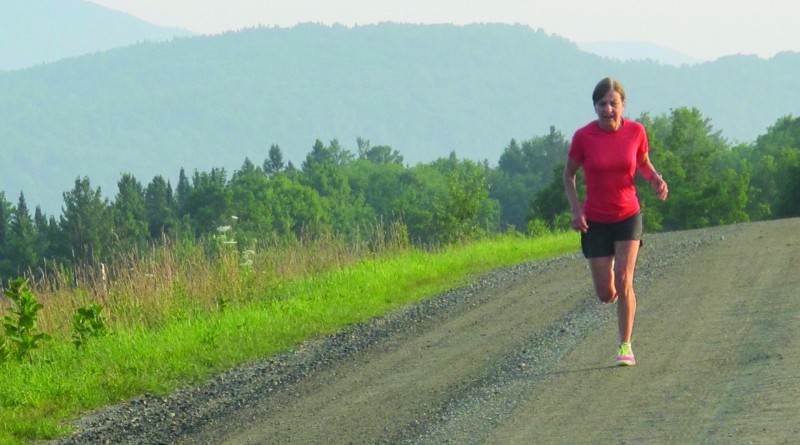8 Steps To Hitting Your Stride (Again)
CRAFTSBURY — Running takes hard work and dedication. If anyone can attest to this, it’s Lynn Jennings, a competitive runner with more U.S. women’s cross-country titles than anyone in history.
Over her 18-year career, Jennings won nine track and field crowns from 1985 to 1996. She won three consecutive women’s world cross-country championship titles from 1990 to 1992. A three-time Olympian, Jennings won the bronze medal in the 10,000 meters at the 1992 Olympic Games in Barcelona. A four-time member of U.S. World Outdoor Championship teams, Jennings medaled at two World Indoor Championships, winning 5,000-meter bronze in 1993 and silver in 1995.
Jennings also won 10 U.S. Outdoor Champion titles and set the women’s world indoor 5,000-meter record of 15:22.64 in 1990. Her U.S. 10,000-meter record of 31:19.89, which she set in 1992, lasted for a decade.
So when Jennings’ sympathizes with runners who have taken the winter off from running and are starting to get back into the swing of things, you know she speaks from experience.

“Running is the hardest sport to come back to when you’ve taken time off,” she says. “Whether it’s elective or due to an injury, there’s something lubricating about running every day that you lose when you have to stop. It can be gruesomely hard to start again.”
But picking up running again and taking your abilities to the next level don’t have to be that hard with a little persistence and patience, she says.
As the director of running programs at the Craftsbury Outdoor Center in Craftsbury, Vt., Jennings shares her experience and knowledge every year in a number of camps where she and a staff of coaches show athletes how to train progressively and intelligently to maximize their potential. Though retired from competitive racing, Jennings, 54, is still an avid daily runner and logs between 40 and 60 miles every week. When not running, she is a competitive sculler at the Craftsbury Center and enjoys forest hikes with her dog Towhee.
Jennings took some time out of her day to offer advice on how to ease back into running routine this spring, and then how to break out of any ruts in your training to make this season a winning one.
Hitting Your Stride – Again
When you stop training, de-training happens within days, Jennings says. Even if you’re coming back from a short break, your blood gets thicker and your lungs lose some of their elasticity. Things feel rusty and it can be difficult to regain what you’ve lost. But Jennings has a few pointers on how to hit your stride – again and then stay tuned through the summer and fall.
Start With New Shoes
If you wore your running shoes all fall and then put them up for the winter, before you start again, it’s likely time for a new pair. Shoe construction breaks down over time and for your first day back, you won’t want a pair on which you’ve logged five months worth of miles. Go with a style and fit of running shoes that you know, she says, adding that “the best pair of shoes are still cheaper than one visit to the doctor.”
Easy Does It
If you’re someone who’s used to being active and in good physical shape but had to take time off from running, Jennings suggests a slow start with an easy two or three miles run. Take the next day off and then try it again. After you’ve followed this pattern for one or two weeks, you can begin to ease into running more often while keeping the distances low. Once you’ve reestablished that basic regiment, feel free to increase the volume before adding one longer distance run to your usual routine.
If you’re someone who runs four times a week, one of those runs should be longer, but no more than 10 percent of your normal distance. By staying conservative, you can always leave room to grow instead of over-extending yourself or pushing too hard too soon.
Know Your Mileage Limit
In her top days as a professional runner, Jennings could log 80 to 90 miles in a week – a normal distance for a medium distance runner – and still recover and be ready for the next week’s workouts. But as soon as she pushed to 100 miles, something didn’t feel right.
“Everyone has a mileage limit and some people want to push and find out what that is, but it’s always better to under-train slightly than to over train,” she says.
Initially, you can focus on the distance of your runs and their frequency, but the intensity with which you attack your workouts can wait.
Ramp It Back A Week
Jennings says a popular practice among coaches is to have athletes complete a block of work and then turn down the intensity for a “down week.” As you begin to structure your workouts, Jennings advises you do the same. During your down week, you won’t stop running entirely, but will incorporate other activities or even take an extra rest day. Whether you swim, bike or strength train, letting yourself recover won’t just make things easier; you’ll also be ready to come roaring back and ready to rumble.
Keep Track Of Yourself, And Stay Accountable
Let’s say you’ve started your training again – but are you monitoring your workouts? You can use software programs or a simple notepad and pen, but a basic training log should include the date, weather conditions, how many minutes or miles you ran and how you felt. A running partner can help keep you from weaseling out, but if you don’t have a buddy willing to meet at 6 a.m. for a run, you can even check in with someone later to say what you did and how you felt. Everyday, Jennings and a friend in Boston email each other with the details on their respective workouts. Jennings says the correspondence has helped keep them accountable and push a little further.
“Now she’s regularly running in the 40- to 60-minute range, way more than she ever would have done mostly because she knows she’s going to email me at the end of the day and tell me what she did,” she says.
Ultimately, the best training plan should be flexible and allow you to work around the rest of your busy life, including work, appointments and foul spring weather. When you look back at the work you’ve done, it will also boost your confidence.
Getting Out Of The Rut
So you’ve been training all season and no matter how hard you try, you’re just not getting faster. Your 5K times won’t break 20 minutes or your marathon is never under three hours.
There’s a solution to this problem and it has to do with the way that you approach your training.
In most of the accounts Jennings sees, runners are either over-training or under-training. If you’re having trouble with a plateau, Jennings says there’s a good chance you’re falling into either of these two categories.
“There are people who under-train obsessively and people who over-train obsessively,” she says. “You have the people who hammer every run and then wonder why they don’t have anywhere to go, physically or emotionally when it’s time for a race. Then you have the person who goes out and runs the same three miles easily and then wonders why they’re not getting faster.”
Speed-Play
Runners going the same distance at the same intensity day after day find their body is conditioned to perform for a certain distance at a never-varying rate. To break through that barrier, Jennings advises adding some spice to your workout routines. This can be done through fartlek, a Swedish word for “speed-play,” that adds a variety of speeds to your existing workouts.
Doing this is as easy as inserting short bursts of speed along your normal route. This can be done for a minute or the distance of five telephone poles while running along the road. There are endless ways to vary it, but by adding these shorter bursts, Jennings says you experience harder running and recovery. Try going at about 80 percent of what you might consider a full-speed run.
“It isn’t a speed workout, but you’re injecting some intensity to what otherwise would have been an easy-flowing five-mile run,” she says. “By doing that, you’re asking your heart and lungs to work a little harder and getting used to the idea of pushing the gas pedal down to sustain a pace.”
The more of this you do, the quicker you’ll be able to keep pushing on the “gas pedal” without wanting to relent.
Jennings also suggests finishing your runs with strides, or faster runs of 50 to 100 meters long. Again, Jennings says these aren’t to be treated as sprints.
“You’re just picking up the pace,” she says. “By doing them, you’re experiencing the biomechanics of faster running – running on the balls of your feet, picking up your knees and driving your arms with more intention.” (Jennings advises against doing strides if you’ve just completed a longer distance run.)
Smarter Training
On race day, you’ll want to perform at your best, a place that running coach Jack Daniels referred to as “going into the beyond.”
When a runner trains excessively, they won’t have that extra effort to give since your body hasn’t recovered fully or strengthened.
The problem with runners who over-train, Jennings says, isn’t about intensity; it’s about smarter training.
“I love ambitious, dedicated runners – who doesn’t?” she says. “But you’ve got to have the million-dollar head to go with the million-dollar body. I want runners who are savvy trainers and understand the intention behind a particular workout.”
All runners have to learn to train judiciously and trust the value of the rest day. It can take some re-education, Jennings says, but in the end the effort will be worth it.



